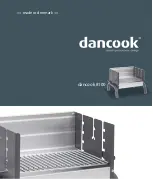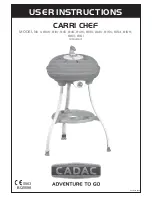
7
English
Cleaning
WARNING:
Blow dirt and dust out of all air vents with
clean, dry air at least once a week. To minimize the risk
of eye injury, always wear ANSI Z87.1 approved eye
protection when performing this procedure.
WARNING:
Never use solvents or other harsh
chemicals for cleaning the non‑metallic parts of the
tool. These chemicals may weaken the plastic materials
used in these parts. Use a cloth dampened only with
water and mild soap. Never let any liquid get inside the
tool; never immerse any part of the tool into a liquid.
MAINTENANCE
WARNING: To reduce the risk of serious personal
injury, turn unit off and keep hands away from
the switch before making any adjustments or
removing/installing attachments or accessories.
An accidental start‑up can cause injury.
Your BLACK+DECKER power tool has been designed to
operate over a long period of time with a minimum of
maintenance. Continuous satisfactory operation depends
upon proper tool care and regular cleaning.
Screw Driving
• For driving fasteners, the reversing button should be
pushed to the left. Use reverse (button pushed to the
right) for removing fasteners. When moving from forward
to reverse, or vice versa, always release the trigger
switch first.
Keyless Chuck (Fig. E)
WARNING:
Make certain the lock‑off button is
engaged to prevent switch actuation before installing
or removing accessories.
WARNING:
Do not attempt to tighten drill bits (or any
other accessory) by gripping the front part of the chuck
and turning the tool on. Damage to the chuck and
personal injury may occur when changing accessories.
To Insert a Drill Bit or Other Accessory
1. Grasp the rear half of the chuck
8
with one hand
and use your other hand to rotate the front half
4
in
the counterclockwise direction, as viewed from the
chuck end.
2. Insert the bit or other accessory fully into the chuck, and
tighten securely by holding the rear half of the chuck and
rotating the front portion in the clockwise direction as
viewed from the chuck end.
Torque Control (Fig. E)
This tool is fitted with a torque adjustment collar
3
to select
the operating mode and to set the torque for tightening
screws. Large screws and hard workpiece materials require a
higher torque setting than small screws and soft workpiece
materials.
• For drilling in wood, metal and plastics, set the collar to
the drilling position symbol
• For screwdriving, set the collar to the desired setting. If
you do not yet know the appropriate setting, proceed as
follows:
• Set the collar to the lowest torque setting.
• Tighten the first screw.
• If the clutch ratchets before the desired result is achieved,
increase the collar setting and continue tightening the
screw. Repeat until you reach the correct setting. Use this
setting for the remaining screws.
Trigger Switch/Reversing Button (Fig. C, D)
1. The drill is turned ON and OFF by pulling and releasing
the trigger switch
1
.
2. A forward/reverse control button
2
determines the
direction of the tool and also serves as a lock off button.
3. To select forward rotation, release the trigger switch and
depress the forward/reverse control button to the left.
4. To select reverse, depress the forward/ reverse control
button the opposite direction.
nOTE:
The center position of the control button locks the
tool in the off position. When changing the position of the
control button, be sure the trigger is released.
Drill Operation (Fig. A)
WARNING: TO REDUCE THE RISK OF PERSONAL
INJURY, ALWAYS
ensure workpiece is anchored or
clamped firmly. If drilling thin material, use a wood
“back‑up” block to prevent damage to the material.
1. For WOOD, use twist bits, spade bits, power auger bits or
hole saws. For METAL, use high‑speed steel twist drill bits
or hole saws. Use a cutting lubricant when drilling metals.
The exceptions are cast iron and brass which should be
drilled dry.
2. Always apply pressure in a straight line with the bit. Use
enough pressure to keep the drill bit biting, but do not
push hard enough to stall the motor or deflect the bit.
3. Hold tool firmly with both hands to control the twisting
action of the drill.
4.
iF DRill sTAlls,
it is usually because it is being
overloaded.
RElEAsE TRiggER iMMEDiATElY,
remove
drill bit from work, and determine cause of stalling.
DO
nOT CliCK TRiggER OFF AnD On in An ATTEMPT
TO sTART A sTAllED DRill – This CAn DAMAgE
ThE DRill.
5. Keep the motor running when pulling the bit back out of
a drilled hole. This will help prevent jamming.
Accessories
WARNING:
Since accessories, other than those offered
by BLACK+DECKER, have not been tested with this
product, use of such accessories with this product
could be hazardous. To reduce the risk of injury, only
BLACK+DECKER recommended accessories should be
used with this product.
Recommended accessories for use with your product
are available at extra cost from your local dealer or
authorized service center. If you need assistance in
locating any accessory, please contact BLACK+DECKER call
1‑800‑544‑6986
.
Summary of Contents for REVCDD12C
Page 26: ......
Page 27: ......
Page 28: ...NA109258 01 22 Black Decker U S Inc 701 East Joppa Road Towson MD 21286 Copyright 2021 ...










































